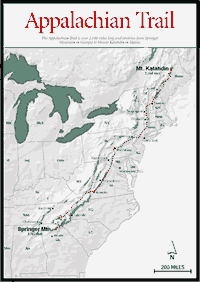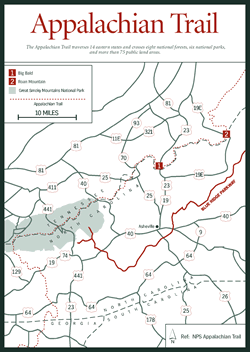
[Figs. 50, 51] Benton MacKaye, a forester, conservationist, and regional planner, first envisioned a footpath through the Appalachian Mountains as a getaway from the stresses of urban culture. Since his proposal in 1921, the Appalachian National Scenic Trail (affectionately known as the AT) has not only become a reality but, for many, a way of life.
Often referred to as the world's most famous hiking trail, the AT runs along the crest of the Appalachian Mountains from Georgia to Maine, marked with white blazes throughout. The trail traverses 14 eastern states and crosses eight national forests, six national parks, and more than 75 public land areas. Lying within a day's drive of two-thirds of the nation's population, the AT receives several million visitors per year. Inspired by Benton MacKaye's dream, the Appalachian Trail was designed, constructed, and marked throughout the 1920s and 1930s by volunteer hiking clubs joined together by the Appalachian Trail Conference (ATC). In 1968, President Lyndon Johnson signed the National Trails System Act, making the Appalachian Trail the first National Scenic Trail, and the National Park Service was delegated overall responsibility for the trail. Federal agencies began purchasing land in order to protect the trailway from urban development; currently, only 36 miles of the trail remain unprotected.
 Although
the AT most recently measured 2,160 miles, relocations and other improvements
to the route cause the trail's distance to change almost yearly. For example,
the Blue Ridge Parkway in North Carolina and Skyline Drive in Virginia displaced
more than 120 miles of the trail when they were constructed.
Although
the AT most recently measured 2,160 miles, relocations and other improvements
to the route cause the trail's distance to change almost yearly. For example,
the Blue Ridge Parkway in North Carolina and Skyline Drive in Virginia displaced
more than 120 miles of the trail when they were constructed.
Designed to delight hikers, backpackers, and nature lovers of all sorts, the AT also serves the specific purpose of preserving the natural, scenic, historical, and cultural resources of the region. Hikes on the AT range from scenic walks to strenuous scrambles up spiring peaks, and many guidebooks are dedicated to exploring the AT's finest details. More than 4,000 people have hiked the entire distance of the Appalachian Trail, including section hikers, who complete the journey in segments, and through-hikers, who walk the entire length of the trail in one continuous trip. Most through-hikers begin their three-to-six month journey in March at the southernmost terminus of the trail—Springer Mountain, Georgia. Hikers begin in the South where the weather is already warm and enjoy the beautiful unveiling of spring as they move northward. Others, however, begin their trek in Maine at Mount Katadin and hike southward, braving late-season snows and the dreaded bites of blackflies in the summer.
Most forests along the AT have been harvested at least two or three times since colonial days. By doubling the height and tripling the girth of the trees along the trail, one can imagine what the forest may have looked like to the first Europeans exploring the region. Treeline is said to be 7,200 feet in the South, and most of the AT traverses through deciduous hardwood forests composed of hickory, oak, and poplar. As altitude is gained, the evergreen line becomes more apparent, with the forest changing from deciduous, to mixed, to evergreen by 5,800 feet.
Mid-April through mid-May is the peak wildflower season, and trilliums, bloodroot (Sanguinaria canadensis), mayapple (Podophyllum peltatum), bluets (Houstonia caerulea), wild azalea, and pink and yellow lady slippers (Cypripendium acaule and C. calceolus) are common. Heavy rains bring lush vegetation during the summer months, and brightly colored rhododendron and mountain laurel begin coloring the higher elevations in June. The best time to view the fall foliage depends largely on temperature and location. Mother Nature's autumn show begins in late September in the higher elevations and creeps down into the lower elevations throughout October and early November.
The popularity of the AT has added a new common creature to the forest—humans. As many people leave the city to get away from the rat race, they are usually surprised at the number of people they encounter on the trail, especially in the spring and summer months. To really get away, hikers are encouraged to bypass the main areas of busy state and national parks and to venture out on longer trails and to backcountry campsites, where silence still prevails and the moon and stars are the brightest thing in the midnight sky. Campers are also encouraged to use a "minimum impact" camping philosophy—packing out all trash, digging latrines, and camping away from the water sources.
Other common creatures in the southern Appalachian Mountains include white-tailed deer, shrews, spotted skunks (Spilogale putorius), timber rattlesnakes (Crotalus horridus), copperheads (Agkistrodon contortrix), bobcats, and ever-curious deer mice (Peromyscus maniculatus). Wild boars, introduced from Europe in the 1930s by hunting clubs, thrive in the forest environment but also consume more than their fair share of the food required by many native species. Hikers often report soil by the AT that looks farm-plowed—a telltale sign of boars rooting near the trail. These animals are very unpredictable, and hikers are advised to keep their distance.
Also common are black bears, which over the years become increasingly less afraid of humans. While human attacks by these animals are rare, hikers should be on the lookout for protective mother bears with cubs. Feeding these animals is highly discouraged since it trains them to snoop around campsites and even challenge hikers for food. Also, since most human foods are not natural to a bear's diet, they often cause the animal to have unfavorable reactions including aggressive behavior and sickness. The house mouse (Mus musculus), an import from Asia, wins the award from most backpackers as both the cutest and most annoying forest creature. These little rascals inhabit most of the shelters along the trail. Their nocturnal nature keeps them scurrying throughout the night, and they love eating their way into hikers' food bags. Hikers and campers are advised to hang their food bags when leaving them unattended.
Most trail guides cover North Carolina and Tennessee together since many miles of the Appalachian Trail meander back and forth across the land where the two states meet. Combined, the two states offer more than 376 miles of trail. Hikers interested in extended hikes are encouraged to read the North Carolina–Georgia Appalachian Trail Guide and the Tennessee–North Carolina Appalachian Trail Guide, published by the ATC. Similar detailed guides are available for each of the 14 states covered by the AT. If not available at the bookstore, the guidebooks can be ordered from the Appalachian Trail Conference, PO Box 807, Harpers Ferry, WV 25425. Phone (304) 535-6331.